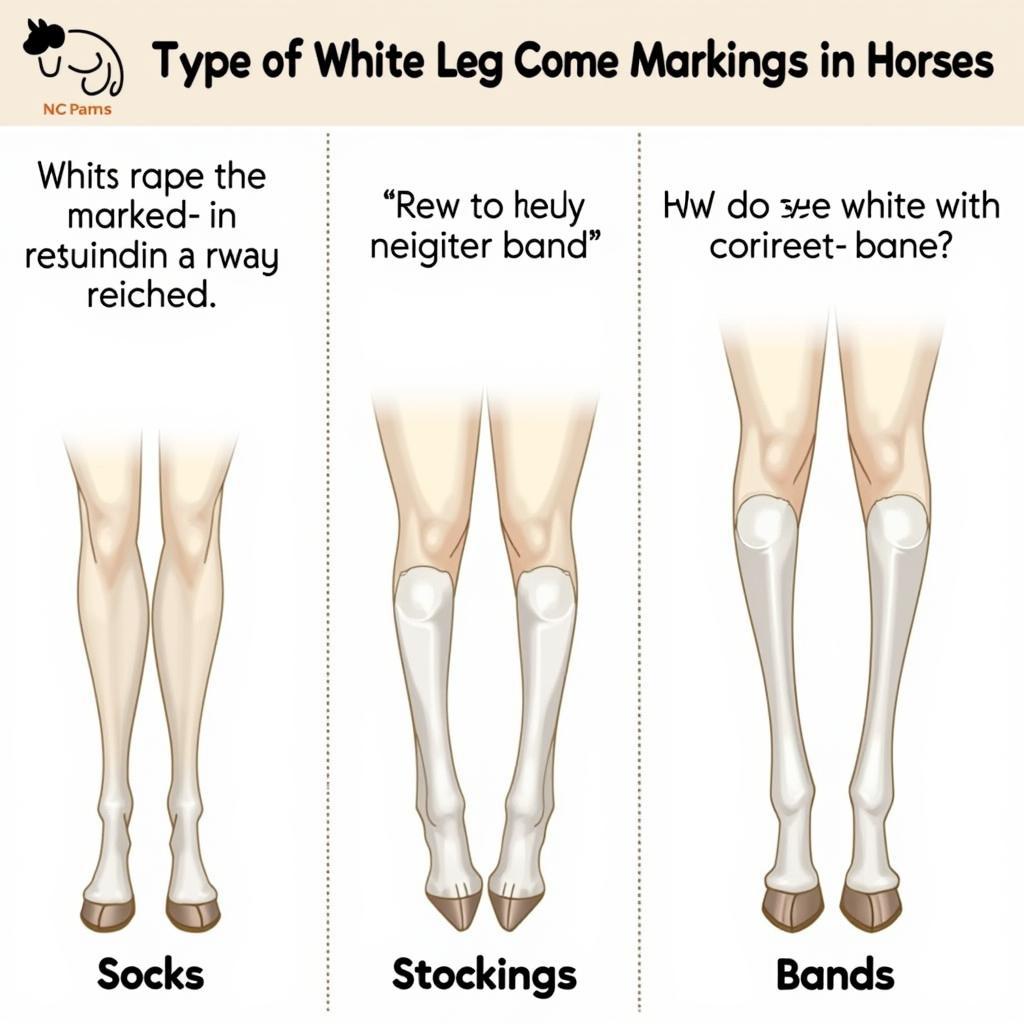Horses with “socks” are a common and captivating sight. These white markings, reminiscent of socks on human legs, add a touch of individuality to a horse’s appearance. But what exactly are these markings, and what do they signify? This article dives into the fascinating world of horse “socks,” exploring their genetics, variations, and the common myths surrounding them.
The term “socks” in the equine world refers to white markings that extend up a horse’s leg, often stopping below the knee or hock. These markings can vary significantly in height, shape, and even texture. While aesthetically pleasing, these markings also offer a glimpse into a horse’s genetic makeup.
Decoding Horse Sock Markings
Horse sock markings are primarily determined by genetics. Specific genes control the distribution of pigment, resulting in the white patterns we see. These genes can interact in complex ways, leading to a diverse array of sock heights and shapes. Understanding these genetic factors can help breeders predict the likelihood of offspring inheriting specific markings. For instance, two horses with high white socks are more likely to produce foals with similar markings.
Variations in Sock Height and Shape
Horse socks can range from a small white “ankle sock” to a marking that extends almost to the knee or hock. Some socks have clean, distinct edges, while others appear feathered or irregular. Certain breeds, like the Clydesdale and Shire, are known for their extensive white markings, often including high socks and facial markings. These breed-specific patterns are often a result of selective breeding over generations.
While many appreciate the stylish look of long boots for horse riding, understanding the unique markings on a horse adds another layer of appreciation for the animal.
The Genetics Behind the Markings
The white markings on a horse, including socks, are essentially areas where the pigment cells (melanocytes) are absent or inactive. This absence of pigment reveals the underlying white hair. The complex interplay of multiple genes dictates where and how these pigment cells function. Research continues to unravel the specific genes responsible for various white patterns, including the fascinating variation in horse sock heights.
Debunking the Myths Surrounding Horse Socks
Many myths and folklore surround horse markings, including socks. Some believe that horses with specific sock patterns have certain personality traits or performance abilities. However, there is no scientific evidence to support these claims. A horse’s temperament and athleticism are determined by a multitude of factors, including genetics, training, and environment, not solely by the presence or absence of white markings.
Do Socks Indicate Temperament or Performance?
The notion that sock markings influence a horse’s personality or athletic ability is purely anecdotal. While some may observe correlations between certain markings and behavior, these are likely coincidental. It’s crucial to assess a horse’s individual qualities rather than relying on superficial markings as indicators of temperament or performance. Considering some comfortable riding socks horse is much more impactful on your ride.
The Importance of Individual Assessment
Each horse is unique, regardless of its coat color or markings. Focus on understanding a horse’s individual personality, training history, and physical capabilities rather than ascribing significance to sock markings or other coat patterns. A thorough assessment is crucial for making informed decisions about horse ownership, training, and management. Much like choosing the right fly socks for horses, selecting the right horse is a matter of individual needs and preferences.
What Are Some Common Questions about Horse Socks?
While we’ve covered the basics, horse owners often have specific questions about these distinctive markings. Let’s address some common inquiries:
How Do Horse Socks Differ from Other Leg Markings?
Horse socks are distinguished by their solid white color and relatively consistent shape. They differ from other leg markings, such as stockings, which extend higher up the leg, and coronet bands, which are thin white markings just above the hoof. Understanding the terminology helps in accurately describing a horse’s markings. Speaking of coronet bands, you can learn more about the coronet horse marking on our website.
 Comparison of Horse Leg Markings
Comparison of Horse Leg Markings
“Understanding the nuances of horse leg markings is essential for accurate identification and record-keeping,” says Dr. Emily Carter, Equine Geneticist. “While visually appealing, these markings offer valuable insights into a horse’s genetic heritage.”
Conclusion: Appreciating the Individuality of Horse Socks
Horse socks are a fascinating aspect of equine coat color and genetics. While they add a touch of visual flair, it’s important to remember that these markings don’t define a horse’s character or abilities. Each horse, with or without socks, is an individual deserving of appreciation and understanding. This knowledge allows us to appreciate the beauty and individuality of each horse, regardless of its “sock” style.
“Remember, a horse’s true beauty lies in its individual spirit and athleticism, not just its coat color,” adds Dr. Carter. “Focus on building a strong bond with your horse based on trust and mutual respect.”
FAQ
- Do horse socks change color over time?
- Can horse socks be artificially created?
- Are certain breeds more prone to having socks?
- Do horse socks offer any protection from the elements?
- What are the different names for horse leg markings?
- Are there health conditions associated with horse socks?
- How can I best care for a horse with white socks?
Need help with your horse? Contact us! Phone: 0772127271, Email: [email protected] or visit us at QGM2+WX2, Vị Trung, Vị Thuỷ, Hậu Giang, Việt Nam. We have a 24/7 customer service team.